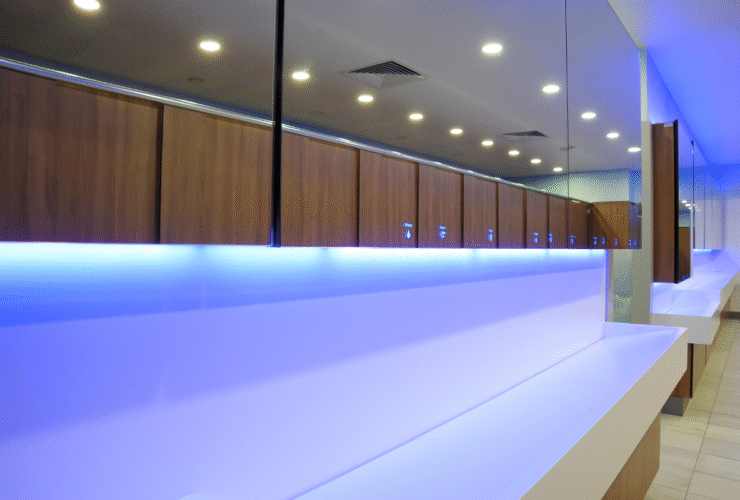Toilet cubicles are one of the most visited spaces in any building. Designing and installing one should involve thorough research and careful planning to ensure that the finished product is safe, long-lasting and durable.
What factors should you take into consideration before deciding on a material for toilet cubicles?
-
- Type of building and expected foot traffic. Will the toilet cubicle be situated in a building with high foot traffic or in a public space? Or will it be in a prestige corporate centre with moderately low foot traffic? If it’s the former, consider the high probability of vandalism when deciding on the price point for the cubicle materials. For prestige buildings, cubicles are usually part of an overall aesthetic and are often designed to display a unique architectural perspective.
- User safety and functionality. If the toilet cubicle is in a preschool or primary school, you will need low-level doors for easier supervision and safety. For high schools, privacy is a major concern, so you’ll need full height doors. Installing the right kind of lock system is also crucial, especially for toilet cubicles that will be used by small children. Vandalism is also a common concern in schools and other publicly used spaces so resistance to graffiti and scratching should be considered when selecting the material.
Knowing the users also help determine the overall aesthetic. Style matters, even with toilet cubicles. For instance, preschool kids who are not yet accustomed to going alone may find brightly coloured school toilet cubicles appealing and comforting.
- Durability and longevity. Toilet cubicles that are always under construction are a hassle for everyone involved—from building administration to contractor, and especially for users. Aside from inevitable elements like moisture, chemicals and humidity, the level and frequency of usage can also contribute to structural deterioration. Choosing the right material can help prevent or minimise the need for constant renovation.
- Ease of cleaning and maintenance. No matter how durable a material is, if not maintained properly and regularly, it will succumb to early wear. It is important to choose a material that will easily fit into a cleaning and maintenance schedule.
- Building and fire codes. Make sure to check the local fire code and safety regulations for recommended materials.
Once you’ve identified the functionality and safety factors, it’s time to select the material. The most common choices are Solid Grade Laminate (SGL) or Compact Grade Laminate (CGL), High Pressure Laminate (HPL) and Melamine Faced Chipboard (MFC).
SGL OR CGL: IDEAL FOR DEMANDING ENVIRONMENTS
This type of material is made from multiple layers of high quality kraft paper, which is then bonded by thermosetting resins under high pressure and temperature. The result is a tough, waterproof and high-density hygienic panel. SGL or CGL is extremely durable. It is resistant to many elements and tough conditions including vandalism, water, wear and tear, chemicals, rust and even fire.
In terms of aesthetics, SGL or CGL is available in various colours and wood grain patterns. Its unique black core distinguishes it from other materials. Graphic design can be incorporated in the panels during the fabrication stage. This type of application is popular in school settings where vandalism can be an issue. The use of bright colours and fun design are not only visually appealing; it can also promote more responsible use and care of washroom facilities.
If you are installing a washroom or toilet in a high foot traffic space or in an area with wet conditions like shopping centres, schools, cafes or swimming pools, this is an ideal material.
HPL: IDEAL FOR REASONABLY ROBUST ENVIRONMENTS
High pressure laminate is created by reinforcing layers of high-quality kraft paper under heat and pressure. The resulting material is a hygienic 0.8mm thick and flexible sheet material with one decorative surface. It is tough, durable and resistant to water, moisture, chemicals, heat, abrasion and general wear and tear. HPL is also fire-retardant and anti-bacterial. To achieve a strong finished panel, HPL must be bonded to a high-density core board.
HPL is ideal for areas with high foot traffic and can withstand reasonably robust conditions. For washroom or toilet use, it is suitable for schools, offices or restaurants where the level of use can range from medium to intense. While it is water-resistant, it may not be the best choice for washrooms which are always wet, like sports centres with swimming facilities or camp sites.
MFC: IDEAL FOR LIGHT TO MEDIUM USE IN DRY ENVIRONMENTS
Melamine is an organic compound made by heating an acidic crystalline compound. When combined with other chemicals, it becomes a plastic resin. Melamine laminate is created when the plastic resin is added to a paper base. It is considered a low-pressure laminate.
MFC is created by bonding both sides of two decorative melamine surfaces to a high-density moisture-resistant chipboard under intense heat and temperature. MFC panels can withstand light to medium impact.
Compared to HPL, it has more or less the same look but its core is less dense. Another difference is that HPL manufacturing involves use of adhesives whereas LPL does not. When it comes to price point, HPL is relatively more expensive compared to LPL. LPL is also fire-retardant and anti-bacterial.
MFC is a popular choice because it is cost-efficient, hygienic and lightweight. It is suitable for washrooms located in small offices or quaint cafes. However, it is not recommended for use in wet areas like shower cubicles or partitions. With MFC, it is important to enforce a regular cleaning schedule to prevent moisture from accumulating and penetrating the chipboard core which can weaken the foundation of the material and consequently, the structure itself.
Remember: A safe and sturdy toilet cubicle is essential and non-negotiable to any shared space—whether it’s a prestige corporate headquarters or a high-traffic public area. Make sure that you take into consideration the various factors involved and the benefits of each material to ensure that the toilet cubicle will adequately serve its purpose.



